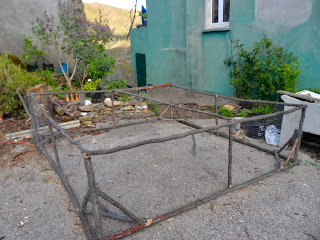The Humble Potato
Following on from my last post, I thought i'd remind those of you whom have forgotten the brilliance and beauty of the humble Potato.
Since its birth, the Potato was rooted in the hills of the highlands of Peru, about 6,000 years ago and even longer. Nowadays, the well travelled spud has more a popular audience, here in Europe and across the water In America, within the past of 500 years of its existence.
The culture of the people before the Incas were the first to land these familiar tubers upon their table, far up in the mountains of the South American Andes.
There, they used the spuds, not only to eat, but use them with strong beliefs of telling the time and predicting the future. These roots were held in such high admiration that their following family in years after, had great importance to them, Quechua Indians, and gave them over 1000 names in their native language.
The Spanish, in the early 15th century, had heard and tried these potatoes when they visited Ecuador, then took them to France, Spain and Italy when they travelled home.
When Sir Frances Drake was on route back from the Caribbean, he stopped off in Colombia and gathered as much potatoes as he could carry whilst on the journey.
There was rumour that Drake gave a few of his left over cache to Sir Walter Raleigh, whom planted them in Ireland.
From there in the spirit of giving, he handed some to Queen Elizabeth I. Her cooks had never the privilege of such a food, that they cooked the plants and not the tubers, which caused the Royal family to suffer a great sickness, and in turn the dearly tubers were banned from England for a hundred years.
This made the potato very undesirable throughout Europe for centuries, and considered only fit for peasants. With thanks to Marie Antoinette whom gave them their following by wearing the blossoms of the potato plant in her hair. Since then they became accepted and became widely used in all of society.
Thanks to the Irish, they became the first European country to farm them, as they were perfect for the conditions of the cool, wet climate that is Ireland.
The potato was the main food for families in the 16th century, which they enjoyed by the load, and the average family ate almost 250 pounds of the spud a week.
Until a great catastrophe in the 1840's when a fungus infected the potato and destroyed the potato plant across the land, causing more than a million people to starve and die a horrible famine. People fled the land to find a better life in America and Australia to save their families. The ones who stayed grappled all they could to sustain their families, praying that they could survive it all.
Their hopes were answered when a wild potato in Chilie was found, this one was resistant to the fungus, and the potato was once again infamous with the Irish people and re-cultivated on the land and in the hearts of the Irish.
This leads me on to how versatile the potato really is, and how far it has come. If you are like us and grow potatoes as a staple to your family, you will have experienced much the same situation with the plants.
We have grown them here for 5years, every year, and continue to grow them as a main crop. Within those 5 years we had a fallen crop which contracted the disease and we almost lost our whole year of food, this passed on to our tomato crop, another member of the nightshade family. That year was a very sad year for us here on the farm.
So, during the lockdown we are now experiencing, I've been using the humble potato a lot. You may have seen my post the other day about the fermenting potato used as yeast for making bread. Thanks to the lovely lady from "Practical Self-Reliance" on the web.
Todays lunch consisted of the humble potato, but with it i added some glorious spring nettles and an onion some garlic and a whole heap of sage.
Check out my recipe page for more details.
This time of year there are thousands of nettles spreading the garden. If i don't use the nettles as a tonic for my plants and soil, i gather them to dry for tea, or add them to soup.
They have a high Iron content and purify the blood. I recommend giving them a try, make your family a nutritious and delicious soup from a proudly honoured potato and some wild garden weedy greens.
They have a high Iron content and purify the blood. I recommend giving them a try, make your family a nutritious and delicious soup from a proudly honoured potato and some wild garden weedy greens.







Comments
Post a Comment